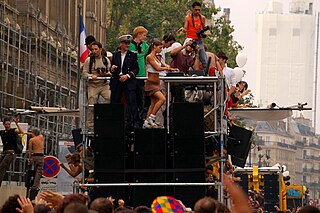This article needs additional citations for verification .(September 2016) |
 A DJ mixing music and multiple dancers at the Paris Techno Parade. The equipment is onboard the float, which has a large speaker setup for the moving crowd. | |
| General Information | |
|---|---|
| Related genres | Trance music, electronic dance music, goa, dub techno, psychedelic trance, happy hardcore, etc. |
| Location | Germany (origin) Worldwide |
| Related events | Music festival, carnival parade, rave, doof, algorave, trance festivals, electronic dance music festivals, teknivals |
| Related topics | Live electronic music |
A technoparade (taken from the German word "Technoparade") is a parade of vehicles equipped with strong loudspeakers and amplifiers playing electronic dance music. It resembles a carnival parade in some respects, but the vehicles (called lovemobiles) are usually less elaborately decorated.[ citation needed ] Unlike some carnival parades, a technoparade does not share the tradition of bombarding the spectators with sweets.[ citation needed ] However, the revellers do occasionally throw confetti (usually larger and more sparkly than that in a carnival parade) and spray foam from the vehicles onto the crowd.[ citation needed ]
Contents
- Official program
- Character
- Major events
- World's largest
- Germany
- Austria
- Switzerland
- Other
- Gallery
- Similar Events
- See also
- References
- External links
Nearly all of the vehicles are converted trucks.[ citation needed ] In order to power the amplifiers, the trucks are frequently equipped with an additional electrical generator.[ citation needed ] For safety reasons, horse-drawn floats are never used in technoparades: there would be a danger of horses panicking from the noise and chaos.[ citation needed ] However, there are occasional human-drawn floats equipped with generators, record players, amplifiers and loudspeakers.[ citation needed ] Some of the vehicles allow people to ride along, for a fee.[ citation needed ] For those on the sidelines, or travelling alongside on foot or bicycles, attendance is free.[ citation needed ]











